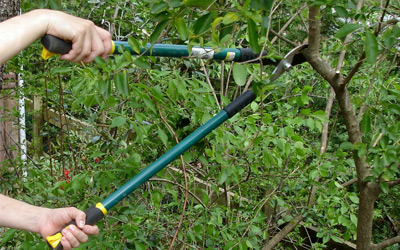Written by Steve Trusty and published on https://garden.org/.
Well, pruned shrubs and trees are a hallmark of a carefully tended yard or garden. Foundation plantings are lush and full, and blooming shrubs display their blossoms on shapely branches that accentuate each plant’s unique style.

In addition to proper planting, watering, and fertilizing; pruning is an important practice for promoting plant health and enhancing the natural size and shape of landscape plants. Pruning is easy—a basic understanding of plant growth, and a few simple techniques, and you’ll be ready to go.
Tips on Pruning Timing and Techniques
Early spring is a great time to prune many trees and shrubs. Start by making sure your pruning tools are nice and sharp. Then check out the following pruning tips for successful snipping this spring.
1. Summer flowering shrubs that bloom on the current season’s growth, such as panicle hydrangea, rose-of-Sharon, and Japanese spirea, can be pruned in early spring to shape the plants, remove older or damaged branches and promote flowering. Plants that are used in formal hedges and foundation plantings such as yew and privet can be trimmed with hedge shears to shape and to spur new growth.
2. Wait to prune spring-flowering shrubs such as forsythia, lilac, deutzia, and spring-flowering spireas until shortly after they have finished blooming. Their flower buds are already formed and pruning before bloom will decrease the floral show.
3. Azaleas can be pruned immediately after they are through blooming to maintain their form. On rhododendrons, remove all spent blooms by snipping or snapping them off at the base of the flower truss, taking care not to damage the buds or new growth arising at the base of the flower truss. To increase blooms, pinch off about an inch of new growth to encourage more shoots to form that will each develop flower buds. But otherwise, broadleaf evergreens need little pruning except when they are young. If you choose a plant whose mature size fits the space allotted to it, you’ll only need to do a little light trimming to shape any wayward growth.
4. Start spring clean-up of roses by cutting out all wood that died over the winter. Cut canes back to healthy, live wood just above an outward-facing bud. Then prune to shape the bush and achieve the desired height.
5. Trim evergreen shrubs like junipers from the bottom up. Shorten branches that are expanding beyond the desired length by cutting them back to a lower branch beneath an overhanging branch. This provides a cleaner look, with the cuts hidden by the branches above.
6. To encourage denser growth or control size, prune pines by snapping off the ends of the new growth ″candles″ before the needles begin to expand. Trim one-third to one-half of the candles to form a fairly dense tree. If you need to severely restrict the current year’s growth, some of the candles can be completely removed at their base.
7. For denser growth, prune spruce by cutting back the long tip of new growth just above the point where the side shoots are forming.
8. The more judicious pruning you do on young deciduous trees, the better off they will be. Remove crossing or rubbing branches, along with ones that are growing at an angle of thirty degrees or less relative to the trunk, as they are weakly joined and more likely to break off in storms. Remove branches that are growing closer to the ground than you would like once they reach about an inch in diameter. Leaving these branches in place when they are smaller than an inch in diameter will result in better root development and a sturdier trunk. Cut back branches to their point origin at the trunk or a lower branch; don’t leave stubs. Small twigs can be cut back to a bud to encourage more branching.
9. When pruning, remove a branch without damaging the tissue of the trunk or the branch it’s attached to in the process. Look for the branch bark ridge (the raised area on the upper surface of the branch where it meets the trunk or larger branch). Then find the branch collar (the bulge that forms at the base of the branch where it intersects with the trunk larger branch). Start your cut just outside the branch-bark ridge and angle it down to just outside the branch collar below. This type of cut exposes only branch tissue, leaving neither a gash against the trunk nor an unsightly stub and helps the cut heal over more readily.
10. Don’t cover pruning cuts with tree paint. Research has shown that sealing cuts and wounds on trees doesn’t speed healing and can, in fact, promote decay.
11. The earlier the better is the motto for pruning most shade and fruit trees. Pruning can be done any time temperatures are above twenty degrees and before spring growth starts.
12. Prune fruit trees to open up the interior, which will allow more light to reach into the crown and promote better fruit production. Pruning methods vary by kind of fruit tree growing. There are even some differences for particular cultivars within a species. Check with your local nursery, garden center, or extension agent for detailed instructions.
Original post here https://ift.tt/3dxmu5G.
The post Pruning Tips And Techniques appeared first on Townsville Tree Lopping Services.
from Townsville Tree Lopping Services https://ift.tt/3fyZKEl
via IFTTT
No comments:
Post a Comment